Salinity Stress Mechanisms in Sepia esculenta Larvae Revealed by Integrated Biochemical and Transcriptome Analyses
Abstract
Simple Summary
Abstract
1. Introduction
2. Materials and Methods
2.1. Acquisition and Processing of Experimental Samples
2.2. Determination of Enzyme Activity and Related Product Content
2.3. Transcriptome Data Processing and Analysis
2.4. Analysis of DEGs
2.5. Functional Analysis of DEGs
2.6. Protein-Protein Interaction Networks Analysis
2.7. qRT-PCR Validation
2.8. Statistical Analysis
3. Results
3.1. Sequencing Results
3.2. Enzyme Activity and Peroxide Content
3.3. Identification of DEGs
3.4. Clustering Heatmap Analysis
3.5. Functional Analysis of DEGs
3.6. GSEA Analysis
3.7. Analysis of PPI
3.8. qRT-PCR Validation of DEGs
4. Discussion
4.1. Expression and Functional Enrichment Analysis of DEGs
4.2. Discussion on Enzyme Activity and Peroxide Content
4.3. Chemokine Signaling Pathway
4.4. MAPK Signaling Pathway
4.5. Cell Cycle Pathway
4.6. Review of Key Gene Sets and Genes Under Different Salinity Stress
5. Conclusions
Supplementary Materials
Author Contributions
Funding
Institutional Review Board Statement
Informed Consent Statement
Data Availability Statement
Conflicts of Interest
Abbreviations
| S. esculenta | Sepia esculenta |
| GO | Gene Ontology |
| KEGG | Kyoto Encyclopedia of Genes and Genomes |
| DEGs | Differentially expressed genes |
| qRT-PCR | quantitative Reverse Transcription Polymerase Chain Reaction |
| PPI | Protein-Protein Interaction |
| GSEA | Gene Set Enrichment Analysis |
References
- Aura, C.M.; Saitoh, S.-I.; Liu, Y.; Hirawake, T.; Baba, K.; Yoshida, T. Implications of Marine Environment Change on Japanese Scallop (Mizuhopecten yessoensis) Aquaculture Suitability: A Comparative Study in Funka and Mutsu Bays, Japan. Aquacult. Res. 2014, 47, 2164–2182. [Google Scholar] [CrossRef]
- Zhou, C.; Wong, K.; Tsou, J.Y.; Zhang, Y. Detection and Statistics of Offshore Aquaculture Rafts in Coastal Waters. J. Mar. Sci. Eng. 2022, 10, 781. [Google Scholar] [CrossRef]
- Sinha, A.K.; AbdElgawad, H.; Zinta, G.; Dasan, A.F.; Rasoloniriana, R.; Asard, H.; Blust, R.; Boeck, G.D. Nutritional Status as the Key Modulator of Antioxidant Responses Induced by High Environmental Ammonia and Salinity Stress in European Sea Bass (Dicentrarchus labrax). PLoS ONE 2015, 10, e0135091. [Google Scholar] [CrossRef]
- Evans, T.G.; Kültz, D. The Cellular Stress Response in Fish Exposed to Salinity Fluctuations. J. Exp. Zool. A 2020, 333, 421–435. [Google Scholar] [CrossRef] [PubMed]
- Lu, M.; Su, M.; Liu, N.; Zhang, J. Effects of Environmental Salinity on the Immune Response of the Coastal Fish Scatophagus argus during Bacterial Infection. Fish Shellfish Immunol. 2022, 124, 401–410. [Google Scholar] [CrossRef]
- Gonzalez, R.J. The Physiology of Hyper-Salinity Tolerance in Teleost Fish: A Review. J. Comp. Physiol. B 2011, 182, 321–329. [Google Scholar] [CrossRef]
- Hossain, M.A.; Aktar, S.; Qin, J.G. Salinity Stress Response in Estuarine Fishes from the Murray Estuary and Coorong, South Australia. Fish Physiol. Biochem. 2016, 42, 1571–1580. [Google Scholar] [CrossRef]
- Röthig, T.; Trevathan-Tackett, S.M.; Voolstra, C.R.; Ross, C.; Chaffron, S.; Durack, P.J.; Warmuth, L.M.; Sweet, M. Human-Induced Salinity Changes Impact Marine Organisms and Ecosystems. Glob. Change Biol. 2023, 29, 4731–4749. [Google Scholar] [CrossRef] [PubMed]
- Maynard, A.; Bible, J.M.; Pespeni, M.H.; Sanford, E.; Evans, T.G. Transcriptomic Responses to Extreme Low Salinity among Locally Adapted Populations of Olympia Oyster (Ostrea lurida). Mol. Ecol. 2018, 27, 4225–4240. [Google Scholar] [CrossRef] [PubMed]
- Knowles, G.; Handlinger, J.; Jones, B.; Moltschaniwskyj, N. Hemolymph Chemistry and Histopathological Changes in Pacific Oysters (Crassostrea gigas) in Response to Low Salinity Stress. J. Invertebr. Pathol. 2014, 121, 78–84. [Google Scholar] [CrossRef]
- Li, Z.; Bao, X.; Liu, X.; Wang, Y.; Zhu, X.; Zhang, Y.; Wang, Z.; Maslennikov, S.; Whiteside, M.; Wang, W.; et al. Transcriptome Analysis Provides Preliminary Insights into the Response of Sepia esculenta to High Salinity Stress. Agric. Commun. 2024, 2, 100064. [Google Scholar] [CrossRef]
- Qian, X.; Ba, Y.; Zhuang, Q.; Zhong, G. RNA-Seq Technology and Its Application in Fish Transcriptomics. OMICS J. Integr. Biol. 2014, 18, 98–110. [Google Scholar] [CrossRef]
- Bao, X.; Wang, W.; Chen, X.; Feng, Y.; Xu, X.; Sun, G.; Li, B.; Liu, X.; Li, Z.; Yang, J. Exploration of Immune Response Mechanisms in Cadmium and Copper Co-Exposed Juvenile Golden Cuttlefish (Sepia esculenta) Based on Transcriptome Profiling. Front. Immunol. 2022, 13, 963931. [Google Scholar] [CrossRef]
- Zhao, Y.; Chang, D.; Zheng, Y.; Zhang, Y.; Wang, Y.; Bao, X.; Sun, G.; Feng, Y.; Li, Z.; Liu, X.; et al. Comparative Transcriptome Analysis Reveals Differences in Immune Responses to Copper Ions in Sepia esculenta under High-Temperature Conditions. BMC Genom. 2025, 26, 262. [Google Scholar] [CrossRef]
- Liu, X.; Wang, W.; Zhao, H.; Wang, Y.; Jiang, L.; Zhang, E.; Feng, Y.; Wang, X.; Qu, J.; Yang, J.; et al. Transcriptome Profiling of Triploid Crassostrea gigas Gills Indicates the Host Immune Mechanism against Bacterial Infection. Comp. Biochem. Physiol. Part D Genom. Proteom. 2025, 54, 101392. [Google Scholar] [CrossRef] [PubMed]
- Guerreiro, M.F.; Borges, F.O.; Santos, C.P.; Rosa, R. Future Distribution Patterns of Nine Cuttlefish Species under Climate Change. Mar. Biol. 2023, 170, 159. [Google Scholar] [CrossRef]
- Guo, H.; Zhang, D.; Wang, L.; Li, W.; He, P.; Näslund, J.; Zhang, X. Sperm Competition in Golden Cuttlefish Sepia esculenta: The Impact of Mating Order and Male Size. Aquaculture 2021, 530, 735929. [Google Scholar] [CrossRef]
- Xu, G.; Pan, Y.; Gu, W.; Huang, T.; Liu, E.; Wang, G. Evaluation of the Acute Toxic Effects of Ammonia on Juvenile Ussuri Cisco (Coregonus Ussuriensis) Based on Histopathology, Antioxidant Enzyme Activity, Immune Response and the Integrated Biomarker Response. Mar. Pollut. Bull. 2024, 209, 117215. [Google Scholar] [CrossRef] [PubMed]
- Xu, A.; Han, F.; Zhang, Y.; Chen, S.; Bian, L.; Gao, T. Transcriptomic Profiling Reveals the Immune Response Mechanism of the Thamnaconus Modestus Induced by the Poly (I:C) and LPS. Gene 2024, 897, 148065. [Google Scholar] [CrossRef]
- Ubhi, T.; Brown, G.W. Exploiting DNA Replication Stress for Cancer Treatment. Cancer Res. 2019, 79, 1730–1739. [Google Scholar] [CrossRef]
- Ekundayo, B.; Bleichert, F. Origins of DNA Replication. PLOS Genet. 2019, 15, e1008320. [Google Scholar] [CrossRef]
- Dong, X.; Kim, Y.-S.; Kim, E.-K.; Shin, W.-B.; Park, J.-S.; Kim, S.-J.; Go, E.-A.; Park, P.-J.; Kwon, S.-C. Scallop Extracts Inhibited LPS-Induced Inflammation by Suppressing MAPK and NF-κB Activation in RAW264.7 Macrophages. Adv. Exp. Med. Biol. 2019, 1155, 1069–1081. [Google Scholar] [CrossRef]
- Portillo-López, A.; Gould, M.C.; Stephano, J.L. MAPK Is Involved in Metaphase I Arrest in Oyster and Mussel Oocytes. Biol. Cell 2003, 95, 275–282. [Google Scholar] [CrossRef] [PubMed]
- Wang, L.; Song, X.; Song, L. The Oyster Immunity. Dev. Comp. Immunol. 2018, 80, 99–118. [Google Scholar] [CrossRef] [PubMed]
- Yang, W.; Tran, N.T.; Zhu, C.-H.; Yao, D.-F.; Aweya, J.J.; Gong, Y.; Ma, H.-Y.; Zhang, Y.-L.; Li, G.-L.; Li, S.-K. Immune Priming in Shellfish: A Review and an Updating Mechanistic Insight Focused on Cellular and Humoral Responses. Aquaculture 2021, 530, 735831. [Google Scholar] [CrossRef]
- Muta, T.; Iwanaga, S. The Role of Hemolymph Coagulation in Innate Immunity. Curr. Opin. Immunol. 1996, 8, 41–47. [Google Scholar] [CrossRef] [PubMed]
- Kong, X.; Wang, S.; Jiang, H.; Nie, G.; Li, X. Responses of Acid/Alkaline Phosphatase, Lysozyme, and Catalase Activities and Lipid Peroxidation to Mercury Exposure during the Embryonic Development of Goldfish Carassius auratus. Aquat. Toxicol. 2012, 120–121, 119–125. [Google Scholar] [CrossRef]
- Kim, J.-H.; Kim, S.K.; Hur, Y.B. Toxic Effects of Waterborne Nitrite Exposure on Antioxidant Responses, Acetylcholinesterase Inhibition, and Immune Responses in Olive Flounders, Paralichthys olivaceus, Reared in Bio-Floc and Seawater. Fish Shellfish Immunol. 2020, 97, 581–586. [Google Scholar] [CrossRef]
- White, C.C.; Viernes, H.; Krejsa, C.M.; Botta, D.; Kavanagh, T.J. Fluorescence-Based Microtiter Plate Assay for Glutamate-Cysteine Ligase Activity. Anal. Biochem. 2003, 318, 175–180. [Google Scholar] [CrossRef]
- Wu, H.; Kong, Y.; Zhao, W.; Wang, F. Measurement of Cellular MDA Content through MTBE-Extraction Based TBA Assay by Eliminating Cellular Interferences. J. Pharm. Biomed. Anal. 2024, 248, 116332. [Google Scholar] [CrossRef]
- Li, Z.; Liu, X.; Liu, J.; Zhang, K.; Yu, H.; He, Y.; Wang, X.; Qi, J.; Wang, Z.; Zhang, Q. Transcriptome Profiling Based on Protein–Protein Interaction Networks Provides a Core Set of Genes for Understanding Blood Immune Response Mechanisms against Edwardsiella Tarda Infection in Japanese Flounder (Paralichthys olivaceus). Dev. Comp. Immunol. 2018, 78, 100–113. [Google Scholar] [CrossRef]
- Li, Q.; Verma, I.M. NF-kappaB Regulation in the Immune System. Nat. Rev. Immunol. 2002, 2, 725–734. [Google Scholar] [CrossRef]
- Paciolla, M.; Boni, R.; Fusco, F.; Pescatore, A.; Poeta, L.; Ursini, M.V.; Lioi, M.B.; Miano, M.G. Nuclear Factor-Kappa-B-Inhibitor Alpha (NFKBIA) Is a Developmental Marker of NF-κB/P65 Activation during in Vitro Oocyte Maturation and Early Embryogenesis. Hum. Reprod. 2011, 26, 1191–1201. [Google Scholar] [CrossRef]
- Qin, J.; Yang, J.; Li, J.; Zhao, D.; An, J.; Zhai, Z.; Wang, H.; Li, J.; Dou, M.; Du, R. Role of NF-κB Signaling Pathway in H2O2-Induced Oxidative Stress of hiPSCs. Vitr. Cell. Dev. Biol. Anim. 2024, 60, 1021–1033. [Google Scholar] [CrossRef]
- Fang, J.Y.; Richardson, B.C. The MAPK Signalling Pathways and Colorectal Cancer. Lancet Oncol. 2005, 6, 322–327. [Google Scholar] [CrossRef] [PubMed]
- Li, S.; Hao, G.; Li, J.; Peng, W.; Geng, X.; Sun, J. Comparative Analysis of Dual Specificity Protein Phosphatase Genes 1, 2 and 5 in Response to Immune Challenges in Japanese Flounder Paralichthys olivaceus. Fish Shellfish Immunol. 2017, 68, 368–376. [Google Scholar] [CrossRef] [PubMed]
- Sun, Y.; Chu, Q.; Zhao, X.; Zhou, Z.; Bi, D.; Xu, T. microRNA-375 Modulates the NF-κB Pathway in Miiuy Croaker by Targeting DUSP1 Gene. Dev. Comp. Immunol. 2018, 86, 196–202. [Google Scholar] [CrossRef]
- Davis, J.E.; Gabler, N.K.; Walker-Daniels, J.; Spurlock, M.E. The C-Jun N-Terminal Kinase Mediates the Induction of Oxidative Stress and Insulin Resistance by Palmitate and Toll-like Receptor 2 and 4 Ligands in 3T3-L1 Adipocytes. Horm. Metab. Res. 2009, 41, 523–530. [Google Scholar] [CrossRef]
- Brenner, D.A.; Seki, E.; Taura, K.; Kisseleva, T.; Deminicis, S.; Iwaisako, K.; Inokuchi, S.; Schnabl, B.; Oesterreicher, C.H.; Paik, Y.H.; et al. Non-Alcoholic Steatohepatitis-Induced Fibrosis: Toll-like Receptors, Reactive Oxygen Species and Jun N-Terminal Kinase. Hepatol. Res. 2011, 41, 683–686. [Google Scholar] [CrossRef]
- Karin, M.; Liu, Z.G.; Zandi, E. AP-1 Function and Regulation. Curr. Opin. Cell Biol. 1997, 9, 240–246. [Google Scholar] [CrossRef] [PubMed]
- Couto, J.A.; Huang, A.Y.; Konczyk, D.J.; Goss, J.A.; Fishman, S.J.; Mulliken, J.B.; Warman, M.L.; Greene, A.K. Somatic MAP2K1 Mutations Are Associated with Extracranial Arteriovenous Malformation. Am. J. Hum. Genet. 2017, 100, 546–554. [Google Scholar] [CrossRef]
- Wortzel, I.; Seger, R. The ERK Cascade: Distinct Functions within Various Subcellular Organelles. Genes Cancer 2011, 2, 195–209. [Google Scholar] [CrossRef]
- Caunt, C.J.; Sale, M.J.; Smith, P.D.; Cook, S.J. MEK1 and MEK2 Inhibitors and Cancer Therapy: The Long and Winding Road. Nat. Rev. Cancer 2015, 15, 577–592. [Google Scholar] [CrossRef] [PubMed]
- Santamaría, D.; Barrière, C.; Cerqueira, A.; Hunt, S.; Tardy, C.; Newton, K.; Cáceres, J.F.; Dubus, P.; Malumbres, M.; Barbacid, M. Cdk1 Is Sufficient to Drive the Mammalian Cell Cycle. Nature 2007, 448, 811–815. [Google Scholar] [CrossRef] [PubMed]
- Bartek, J.; Lukas, J. Chk1 and Chk2 Kinases in Checkpoint Control and Cancer. Cancer Cell 2003, 3, 421–429. [Google Scholar] [CrossRef]
- Zhao, C.; Chen, L.; Jin, Z.; Liu, H.; Ma, C.; Zhou, H.; Xu, L.; Zhou, S.; Shi, Y.; Li, W.; et al. Knockdown of MRPL35 Promotes Cell Apoptosis and Inhibits Cell Proliferation in Non-Small-Cell Lung Cancer. BMC Pulm. Med. 2023, 23, 507. [Google Scholar] [CrossRef]
- Ke, Y.; Guo, W.; Huang, S.; Li, Y.; Guo, Y.; Liu, X.; Jin, Y.; Ma, H. RYBP Inhibits Esophageal Squamous Cell Carcinoma Proliferation through Downregulating CDC6 and CDC45 in G1-S Phase Transition Process. Life Sci. 2020, 250, 117578. [Google Scholar] [CrossRef] [PubMed]
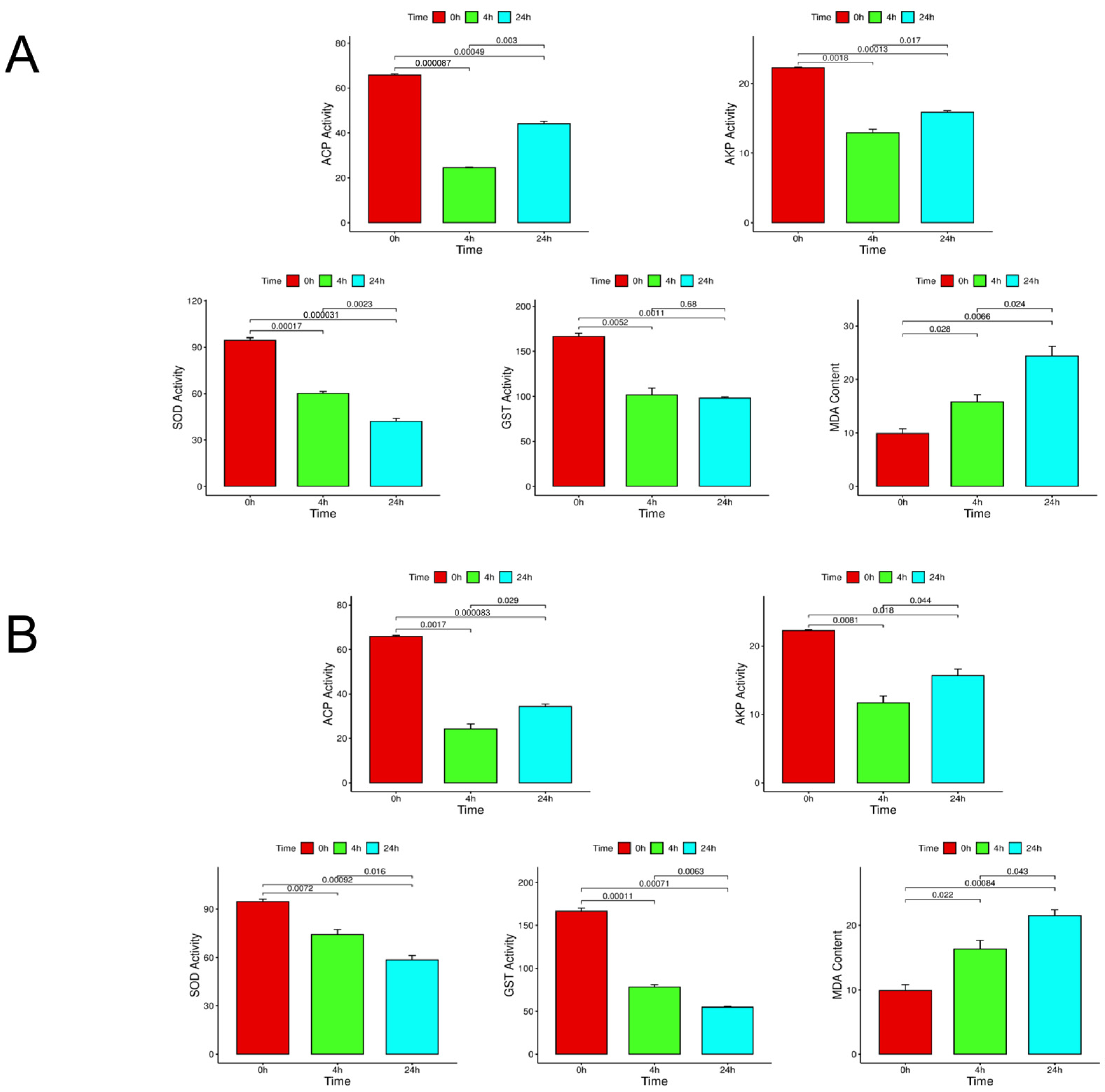
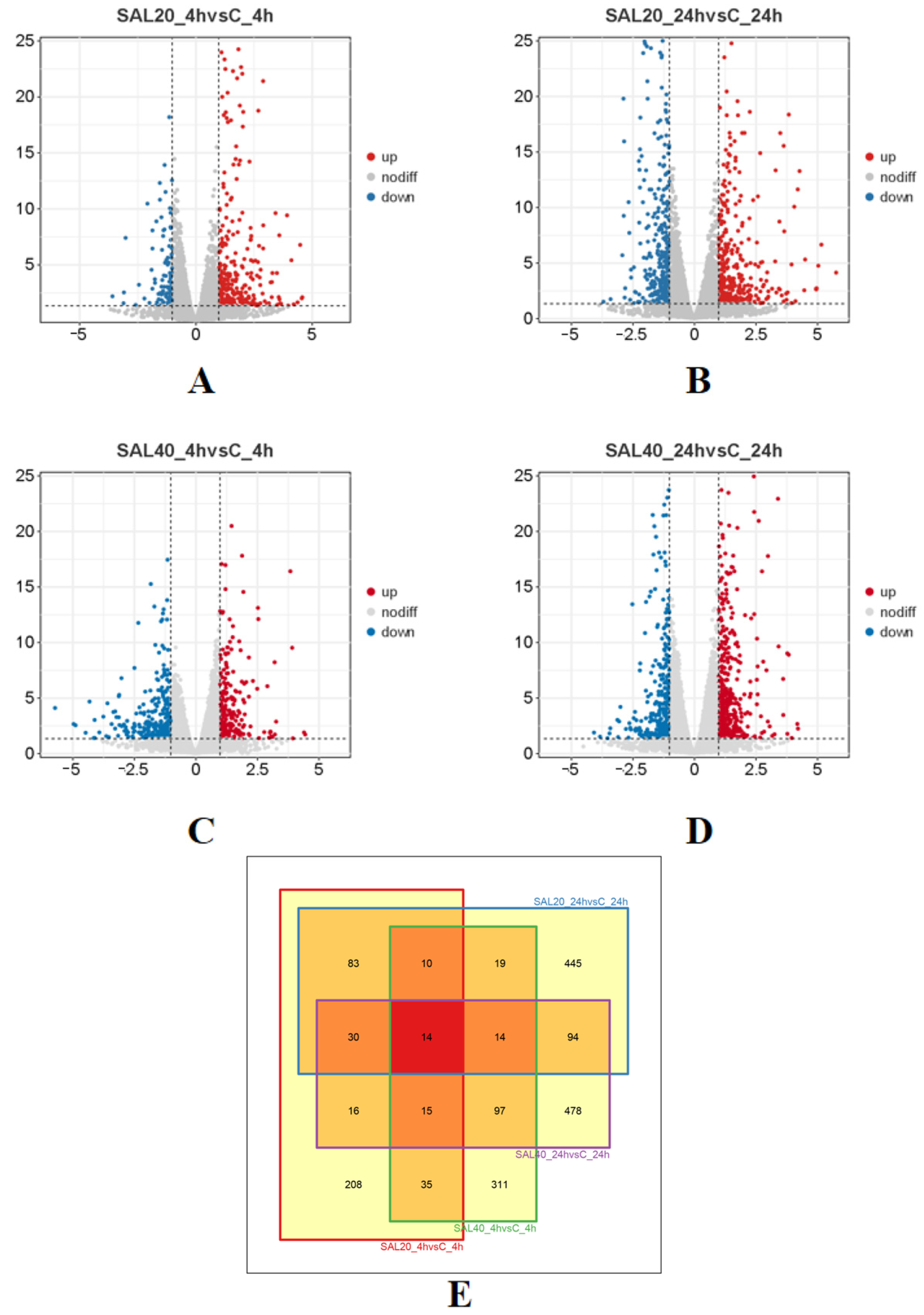
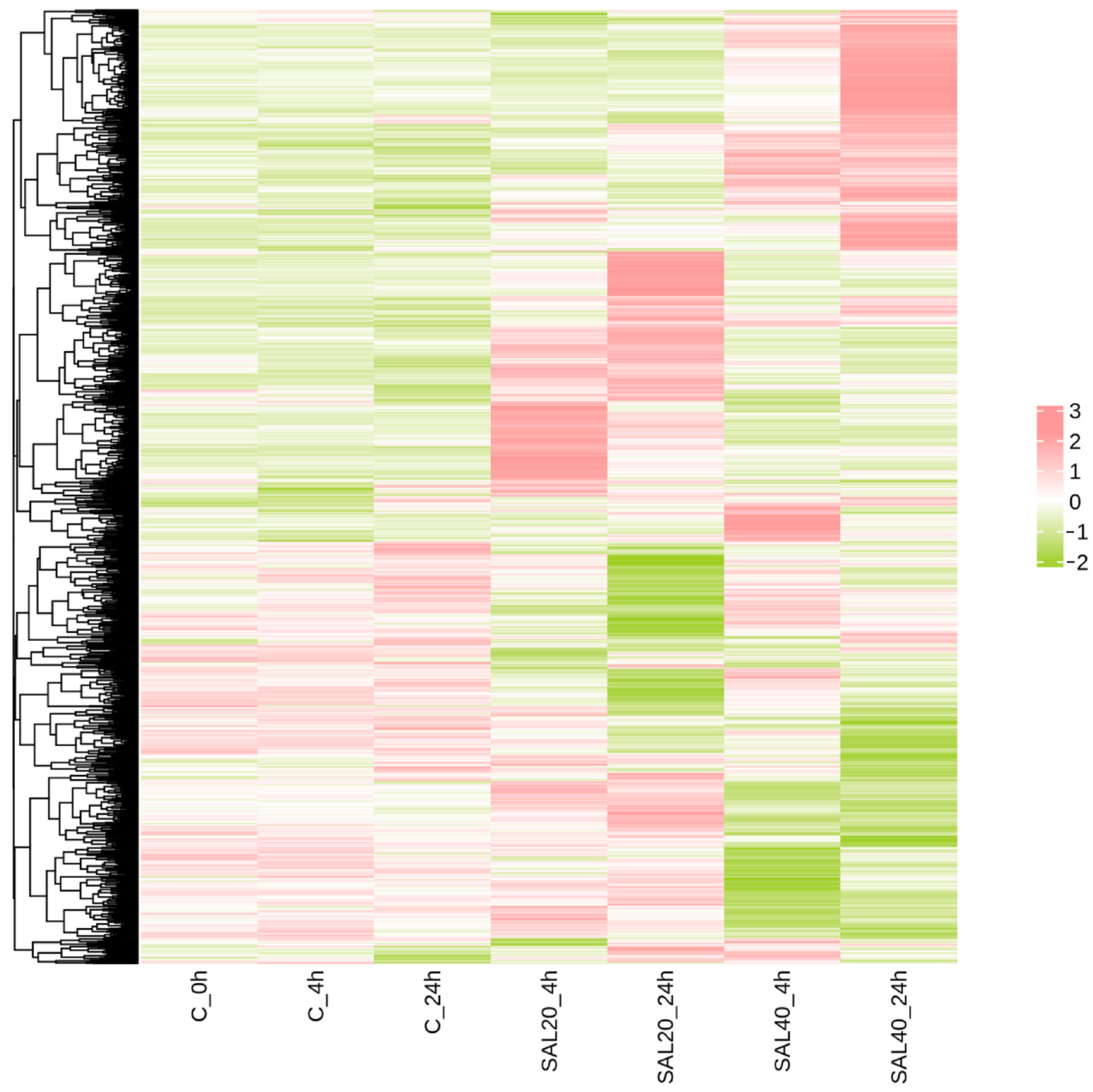
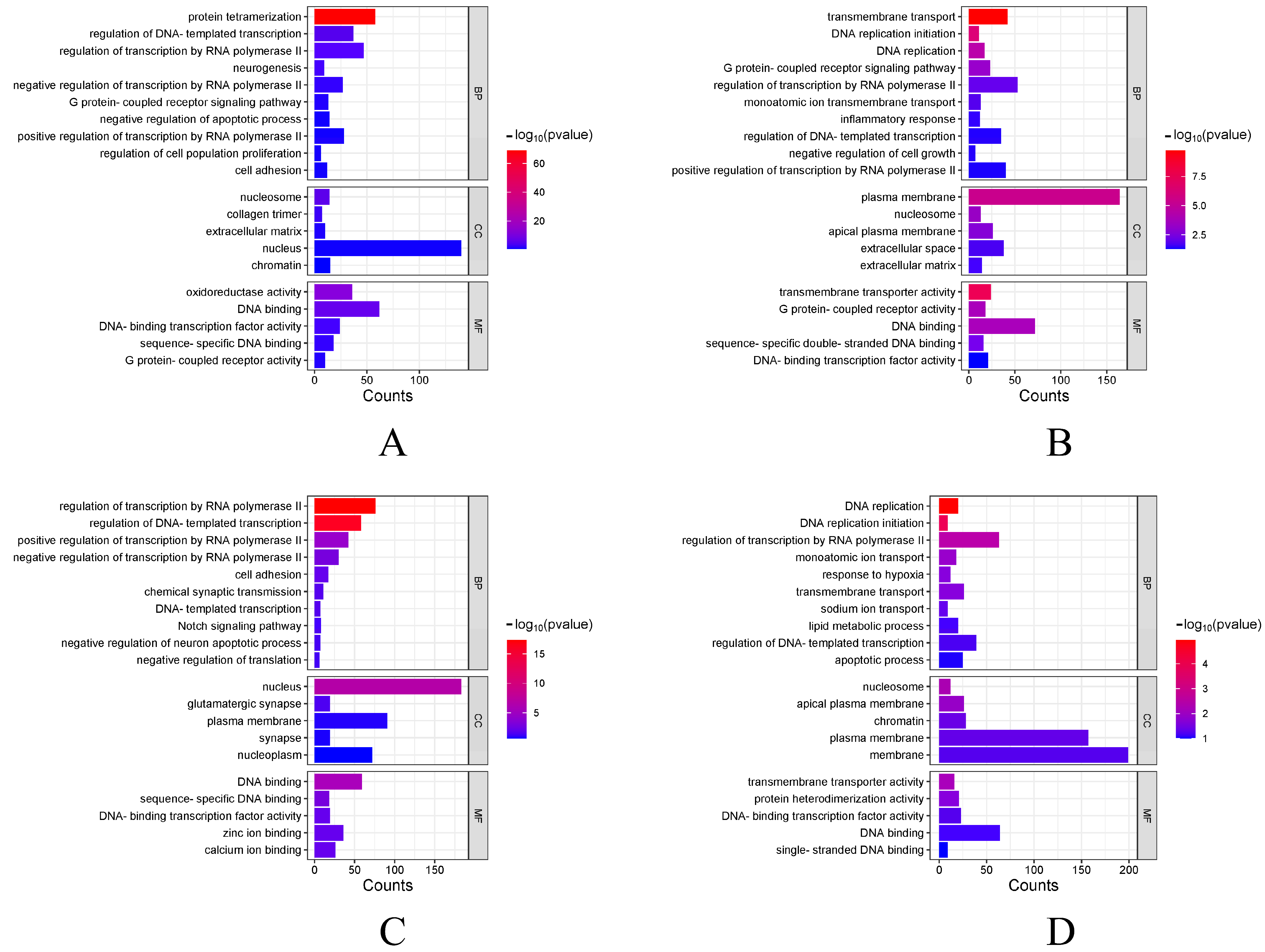
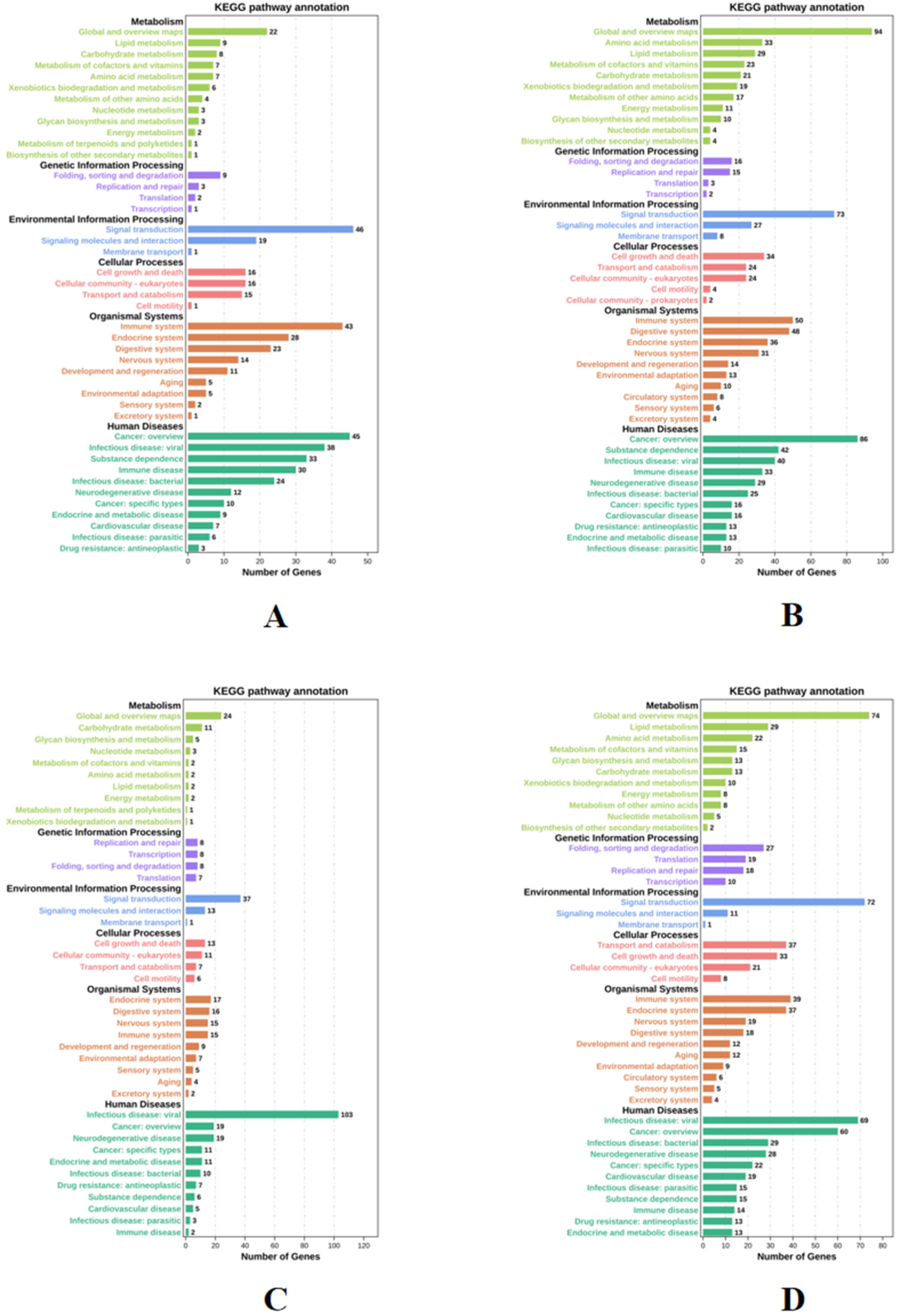
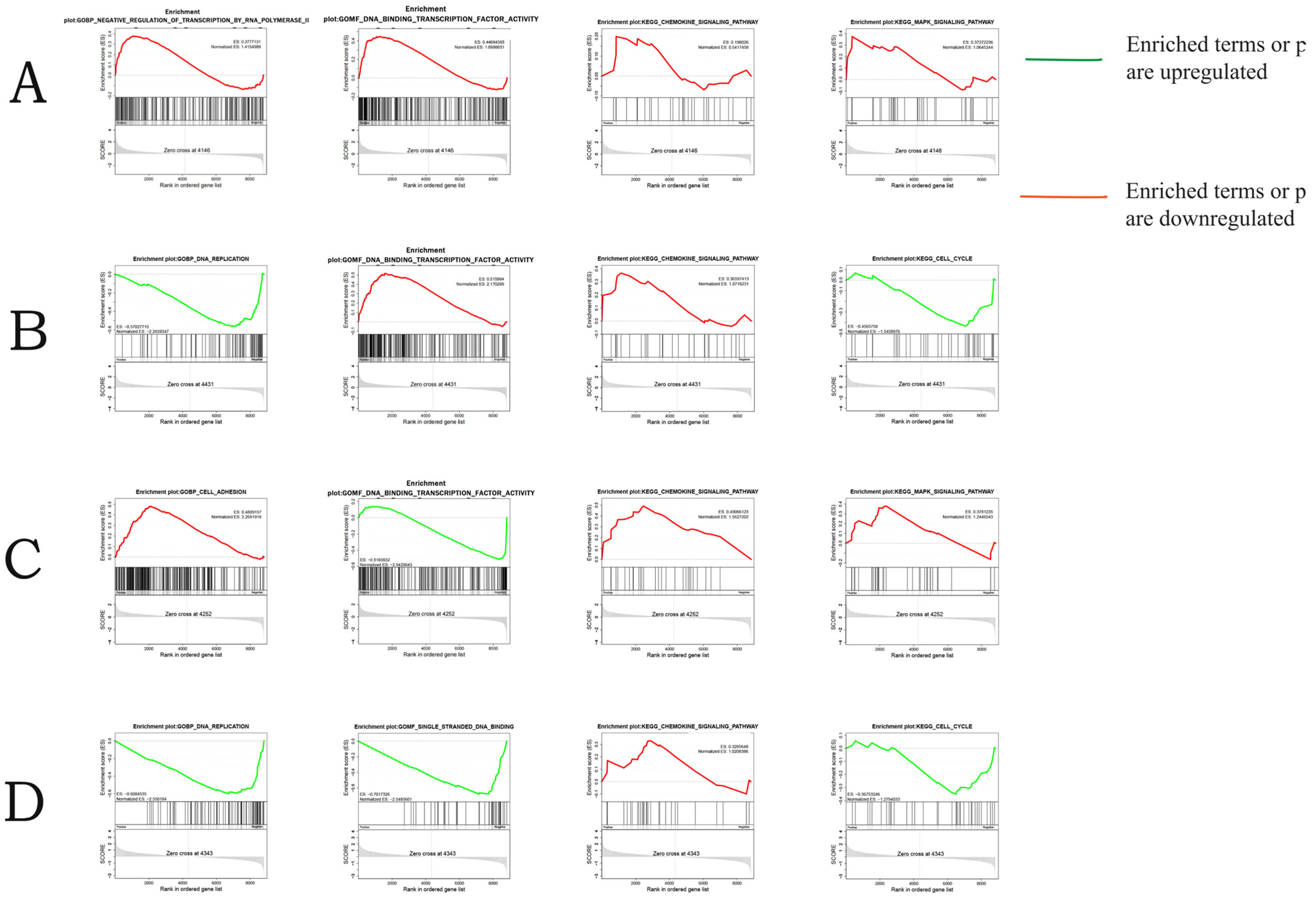
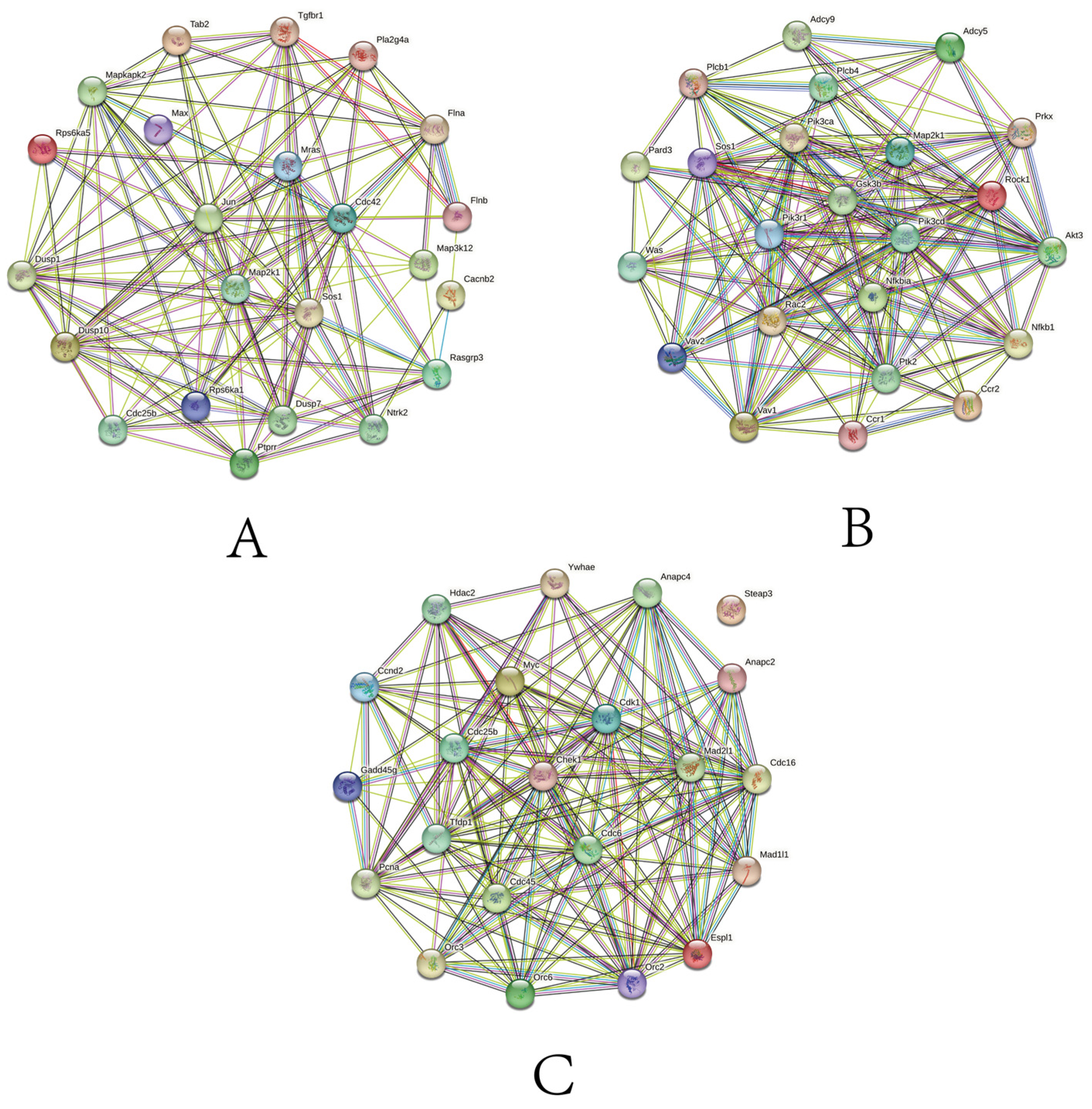
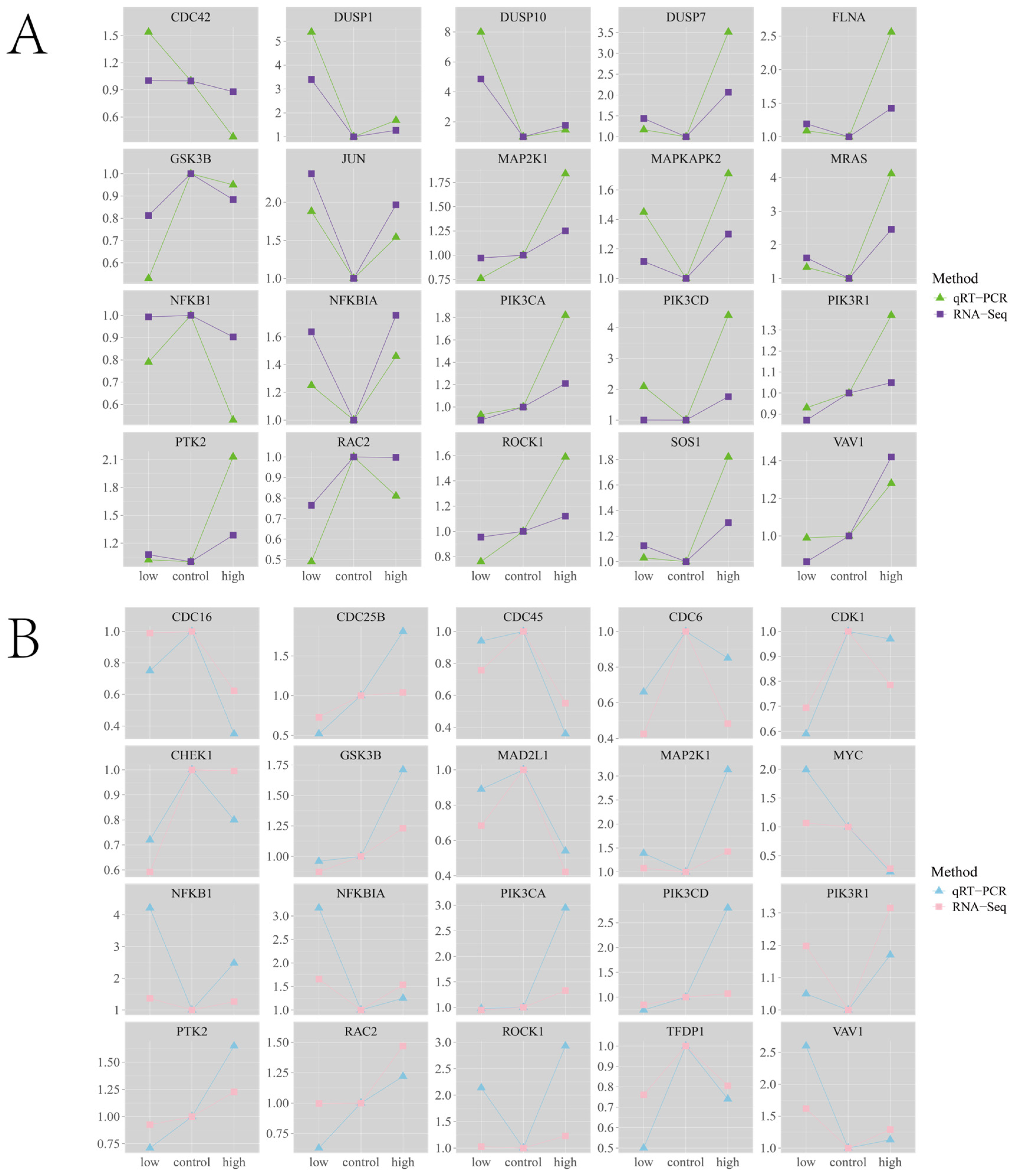
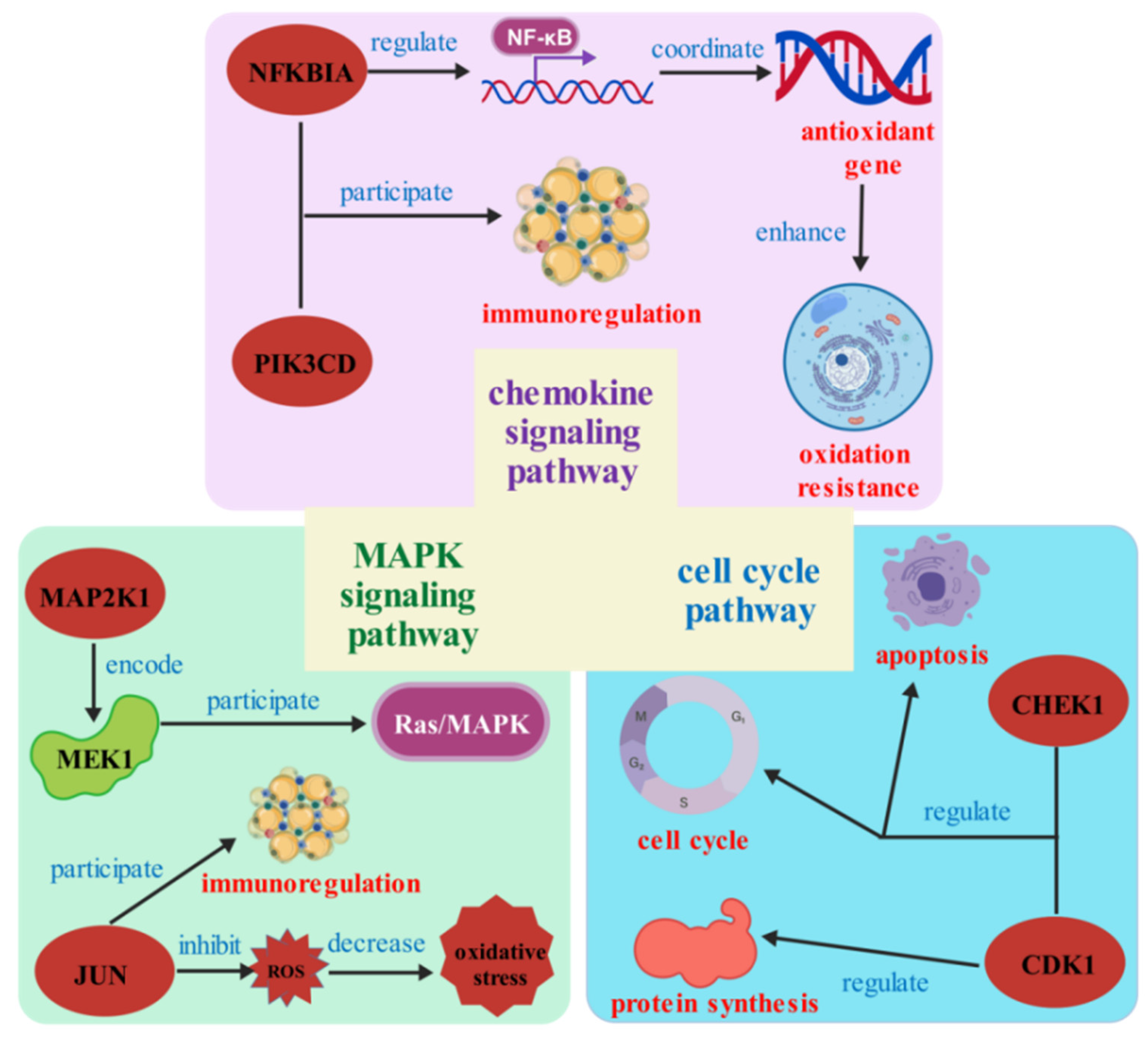
| Gene Name | Forward Primer (5′-3′) | TM (°C) | Reverse Primer (5′-3′) | TM (°C) | Amplicon Length (bp) |
|---|---|---|---|---|---|
| CDC16 | TAGCAAAGCGACCACATTAG | 60 | CTGGGAGGCAGTGAAATAAG | 60 | 118 |
| CDC25B | CTGCCAATAAAGACTGCTATCC | 61 | CTCACACATTTCCGTTCCAC | 61 | 101 |
| CDC42 | GTTGTGGTTGGTGATGGT | 60 | GCCCTGCAGTATCAAAGAG | 60 | 163 |
| CDC45 | CCCGATGATGATGTCTGTTT | 60 | CTGGGATGTCTCTCATTTCTTC | 60 | 121 |
| CDC6 | CAGGTGGCAGCCTTTATATT | 60 | CTCACTCCCATGCAGTTAAG | 60 | 130 |
| CDK1 | GCCAGGAGTAACCTCATTAC | 60 | AAGTCCTGCGTCATCTAATC | 59 | 100 |
| CHEK1 | CTTGGAGAAGGTGCTTATGG | 60 | CCCTGACAGAAACCTCTTTATC | 60 | 106 |
| DUSP1 | GCAGACGTAGCGTCATTT | 60 | GGGAGTGATGATGTCCTAAAC | 60 | 172 |
| DUSP10 | CGGTGCGAATATCCTTATCC | 60 | CGCTTCTGTTTCACGTATCT | 60 | 126 |
| DUSP7 | CCCTTAACGTCCTTGGTATT | 59 | GCTGGATGGATTCTCGTTTA | 60 | 125 |
| ESPL1 | AGCACCACCAGTAGAGATAA | 60 | CTCTTGGCAGTCCTTTAGTG | 60 | 117 |
| FLNA | TGACAGAAGTGCTGCTAAAC | 60 | GGTTCGAGAGGCATGTAATC | 60 | 123 |
| GSK3B | TGTGCCTGAGACTGTGTA | 60 | CTCCTTGGGAATGGATGTATG | 60 | 128 |
| JUN | ATGTGACCGAAGAACAAGAG | 60 | GTGGAGGCGATGTAGAATTT | 60 | 102 |
| MAD2L1 | GGCTTATAGAGATGGTGTTGG | 60 | CCAGTGTCATCTTCCACATC | 60 | 103 |
| MAP2K1 | CCATGACTGGGAAACCTTTA | 60 | AGGGTGGAGGCTCATTTA | 60 | 129 |
| MAPKAPK2 | GCCCAAATCACGAAGAGAA | 60 | CAACAAGGAAGGCACACT | 60 | 112 |
| MRAS | CTTGCCGCTCACCTTAAT | 60 | GTGGCTGCTCTCGAATAAT | 60 | 109 |
| MYC | CACCTGGAACGAGAAAGAAG | 60 | TCGTAGCCTCATCCACAA | 60 | 121 |
| NFKB1 | GCCTGCATAAAGCTGTTAGA | 60 | AGAGCAGTCTGGGACTTT | 60 | 127 |
| NFKBIA | CTGCCCTCCAGAAACATTAC | 60 | CCCATGTTCAGCAGCATAA | 60 | 116 |
| PIK3CA | GCAGGTGATCAGGATTATGG | 60 | GCAGCAGGAACAACTTCA | 60 | 120 |
| PIK3CD | GGTGTTGTACGTGATAGAGTG | 60 | CGGCTGCTGGAACAAATA | 60 | 131 |
| PIK3R1 | GGCGAGTTATCAAGAGAAGAG | 60 | TCTAAGGGTCAGAGTGTAGTC | 60 | 108 |
| PTK2 | GAAGTCACGAGAAAGCTACTG | 60 | CCGAAGTTCATACCTCCATTC | 60 | 106 |
| RAC2 | AGGCAATTGGTGGGTTAG | 59 | CGCAGAACACTCCATGTAT | 60 | 107 |
| ROCK1 | TTGTATGCGGATGGATGTG | 60 | CATCACCACCTTGGGATTT | 60 | 101 |
| SOS1 | CAGGAAGCAAGTGGAGAAAG | 61 | GAACTGTAAGTGGTGAGGAATG | 61 | 125 |
| TFDP1 | GACACATCCTACCTCCTTTATG | 60 | CAACATTTGGGCTTTGATCC | 60 | 133 |
| VAV1 | CAGTGATGACGAGGACATCTA | 61 | CTTCCTCTTCGTACACAACATC | 61 | 101 |
| Sample | Raw Reads | Raw Bases | Clean Reads | Clean Bases | Q20 (%) | Q30 (%) | Total Mapping |
|---|---|---|---|---|---|---|---|
| C_0h_1 | 461,138,06 | 6.92G | 449,821,04 | 6.75G | 97.07 | 92.32 | 39456868 (87.72%) |
| C_0h_2 | 505,451,56 | 7.58G | 493,877,00 | 7.41G | 97.44 | 93.02 | 44052010 (89.20%) |
| C_0h_3 | 475,155,46 | 7.13G | 463,599,16 | 6.95G | 97.27 | 92.68 | 41025164 (88.49%) |
| C_4h_1 | 461,799,90 | 6.93G | 451,241,90 | 6.77G | 96.77 | 91.61 | 39813899 (88.23%) |
| C_4h_2 | 464,091,28 | 6.96G | 449,101,60 | 6.74G | 97.27 | 92.62 | 40048934 (89.18%) |
| C_4h_3 | 443,214,76 | 6.65G | 430,526,24 | 6.46G | 96.27 | 90.81 | 37441672 (86.97%) |
| C_24h_1 | 447,868,92 | 6.72G | 431,101,54 | 6.47G | 95.85 | 90.05 | 37201612 (86.29%) |
| C_24h_2 | 449,431,88 | 6.74G | 433,935,64 | 6.51G | 95.83 | 90.02 | 37413049 (86.22%) |
| C_24h_3 | 457,950,96 | 6.87G | 448,865,64 | 6.73G | 97.42 | 92.92 | 39924459 (88.95%) |
| SAL20_4h_1 | 460,619,26 | 6.91G | 448,902,60 | 6.73G | 97.06 | 92.29 | 39336186 (87.63%) |
| SAL20_4h_2 | 459,147,26 | 6.89G | 445,807,56 | 6.69G | 97.22 | 92.65 | 39383060 (88.34%) |
| SAL20_4h_3 | 501,220,24 | 7.52G | 486,853,20 | 7.30G | 95.69 | 89.74 | 42000224 (86.27%) |
| SAL20_24h_1 | 426,766,10 | 6.40G | 415,836,98 | 6.24G | 97.26 | 92.68 | 36631715 (88.09%) |
| SAL20_24h_2 | 476,870,56 | 7.15G | 463,630,26 | 6.95G | 97.36 | 92.84 | 40997032 (88.43%) |
| SAL20_24h_3 | 464,417,70 | 6.97G | 451,153,78 | 6.77G | 97.41 | 92.91 | 39895803 (88.43%) |
| SAL40_4h_1 | 466,644,44 | 7.00G | 448,498,10 | 6.73G | 97.45 | 93.00 | 39852403 (88.86%) |
| SAL40_4h_2 | 412,505,16 | 6.19G | 401,588,60 | 6.02G | 95.80 | 89.92 | 34776949 (86.60%) |
| SAL40_4h_3 | 455,434,02 | 6.83G | 440,828,56 | 6.61G | 97.33 | 92.81 | 39194280 (88.91%) |
| SAL40_24h_1 | 459,581,10 | 6.89G | 447,316,52 | 6.71G | 97.52 | 93.10 | 39903972 (89.21%) |
| SAL40_24h_2 | 477,382,44 | 7.16G | 465,891,80 | 6.99G | 97.49 | 93.38 | 41137815 (88.30%) |
| SAL40_24h_3 | 476,587,96 | 7.15G | 465,246,48 | 6.98G | 97.21 | 92.51 | 41317022 (88.81%) |
Disclaimer/Publisher’s Note: The statements, opinions and data contained in all publications are solely those of the individual author(s) and contributor(s) and not of MDPI and/or the editor(s). MDPI and/or the editor(s) disclaim responsibility for any injury to people or property resulting from any ideas, methods, instructions or products referred to in the content. |
© 2025 by the authors. Licensee MDPI, Basel, Switzerland. This article is an open access article distributed under the terms and conditions of the Creative Commons Attribution (CC BY) license (https://creativecommons.org/licenses/by/4.0/).
Share and Cite
Zhao, Y.; Zhu, X.; Zhang, J.; Wang, W.; Cui, C.; Tan, X.; Liu, X.; Xu, X.; Li, Z.; Yang, J. Salinity Stress Mechanisms in Sepia esculenta Larvae Revealed by Integrated Biochemical and Transcriptome Analyses. Biology 2025, 14, 1338. https://doi.org/10.3390/biology14101338
Zhao Y, Zhu X, Zhang J, Wang W, Cui C, Tan X, Liu X, Xu X, Li Z, Yang J. Salinity Stress Mechanisms in Sepia esculenta Larvae Revealed by Integrated Biochemical and Transcriptome Analyses. Biology. 2025; 14(10):1338. https://doi.org/10.3390/biology14101338
Chicago/Turabian StyleZhao, Yancheng, Xueyu Zhu, Jingzhao Zhang, Weijun Wang, Cuiju Cui, Xin Tan, Xiumei Liu, Xiaohui Xu, Zan Li, and Jianmin Yang. 2025. "Salinity Stress Mechanisms in Sepia esculenta Larvae Revealed by Integrated Biochemical and Transcriptome Analyses" Biology 14, no. 10: 1338. https://doi.org/10.3390/biology14101338
APA StyleZhao, Y., Zhu, X., Zhang, J., Wang, W., Cui, C., Tan, X., Liu, X., Xu, X., Li, Z., & Yang, J. (2025). Salinity Stress Mechanisms in Sepia esculenta Larvae Revealed by Integrated Biochemical and Transcriptome Analyses. Biology, 14(10), 1338. https://doi.org/10.3390/biology14101338






